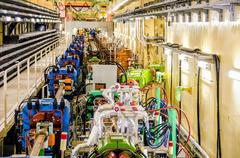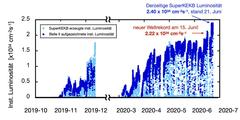URL: https://www.desy.de/news/news_search/index_eng.html
Breadcrumb Navigation
DESY News: Belle II: World record in the accelerator
News
News from the DESY research centre
Belle II: World record in the accelerator
Tailwind for the search for rare particle decay in the Belle II experiment: The SuperKEKB accelerator ring has now achieved the highest luminosity ever measured. The electron-positron accelerator beats not only its predecessor KEKB but also the Large Hadron Collider (LHC) at CERN. This has just been announced by the Japanese research center KEK, the operator of the accelerator.
In SuperKEKB, electrons and positrons are accelerated to high energies and collided in the Belle II detector. Scientists want to find out more about what causes the different behavior of matter and anti-matter in the universe. The German Belle II collaboration developed the innermost detector in Belle II.
Luminosity plays a key role here. It indicates how many particles are gathered per second and square centimeter. It is thus a factor for the number of collisions that take place and which can be evaluated in the Belle II detector. The more measurement data, the higher the probability of finding rare decay. On 15 June 2020, the value was 2.22 × 1034 cm−2s−1.

The SuperKEKB accelerator. Image: KEK
But this is only the beginning. In the next few years, the luminosity will continue to increase to 40-fold the current record. The scientists have come up with a number of technical details.
Target: Increase the collision rate
In order to obtain a high luminosity, scientists can tweak two parameters: the densitiy of the beams of electrons and positrons and the particle stream, i.e. the number of particles per beam.
Italian physicist Pantaleo Raimondi developed the “nano-beam method”, which allows the particle beam to be focused to a beam that is 10 micrometres long and 50 nanometres high. For comparison: Corona viruses are 120–160 nanometers in diameter. The current world record could already be achieved with a 20-micrometre-wide and 220-nanemetre-high beam. The particle stream can also be further improved by a factor of 4 to 5.
The technical innovations

The accelerator has broken its own record since. Image: Belle II collaboration
Effects on the Belle II experiment
The electron and positron beams meet in the center of the Belle II detector. The physicists and engineers in the Belle II consortium use it to study particles created in the collision – essentially B mesons, charm mesons, and tau leptons as well as their corresponding antiparticles.
The behaviour of these particles is largely described in the Standard Model of Particle Physics. However, the Standard Model cannot explain all observable phenomena, for example dark matter or why there is matter but hardly any antimatter in the universe. Researchers hope to find the answers in signals from rare decay processes. The high-performance SuperKEKB machine makes it possible to record and analyse more of these events.
Over the next ten years, Belle II is expected to record 50-fold more collisions than the previous Belle detector. The physicists can then use the experiment to evaluate 50 billion B meson pairs and a similarly high number of charm mesons and tau leptons. This will allow them to delve deeper into the mysteries of the universe than ever before.
The German working groups in the Belle II experiment are funded by the following institutions and programmes:
- European Research Council
- The German Federal Ministry of Education and Research
- German Research Foundation, particularly within the framework of the excellence strategy of the federal government and the federal states:
- “ORIGINS“: EXC-2094 – 390783311
- “Quantum Universe”: EXC-2121 – 390833306
- Helmholtz Society
- European Union’s Horizon 2020 – grant agreement No 822070
- Max Planck Society



